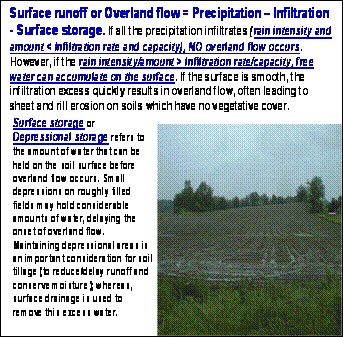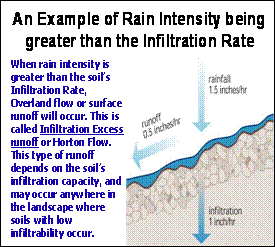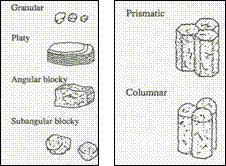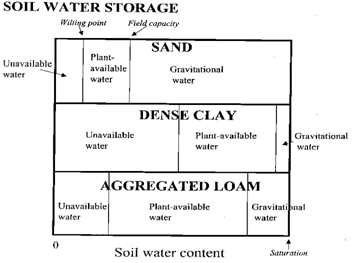|
Soil Water Storage
The soil water storage or soil water content can be quantified on the basis of its volumetric or gravimetric water content. The volumetric water content is the volume of water per unit volume of soil, expressed as a percentage of the volume. The gravimetric water content is the mass of water per unit mass of dry (or wet) soil. The volumetric water content is equal to the gravimetric water content times the soil's bulk density (on a dry soil basis).
Factors that affect the soil water storage are:
- Total Porosity or Void Space
- Pore-size and Distribution and Connectivity
- Soil Water Pressure Potential or Energy Status of the Soil Water
The total porosity or void space ultimately establishes the upper limit of how much water can be stored in a given volume of soil. When all the pores are filled with water the soil is saturated, and cannot store any more water. The total porosity is a function of the soil's particle size, particle uniformity and packing or structure because the void space that remains between the solid particles determines the extent and distribution of pore sizes and their connectivity.
If one fills the same volume with sand and clay sized particles, the total porosity of the clay is somewhat higher, about 50-55% of the volume compared to about 35-40% for sand. The spaces between the sand particles will have larger voids, but there will be fewer of them. The total porosity of medium textured loamy soils is generally around 50% because the smaller silt and clay particles fill some of the voids between the larger sand particles. Soils with good structure will have somewhat higher total porosity than soil that has been compacted (i.e., where the soil particles are forced closer together).
The important influence of pore-size and distribution on soil water storage is in regards to how different pore sizes respond to energy forces or the soil water pressure potential. Under saturated conditions, large pores drain more easily in response to gravity potential. Also, when the soil is unsaturated, large pores are less subject to capillary (or matric potential) forces. In unsaturated soil conditions, the soil water pressure potential becomes negative (suction), and the degree to which this occurs greatly influences the soil water storage (retention) or water content in different sized pores.
The soil water characteristic (retention) curve defines the relationship between the soil water pressure potential or energy status (matric or suction potential) and the soil water content. It's important to note that soil water moves in direct response to the energy or pressure potential forces acting upon it (i.e., moving from a higher to lower energy status), and not necessarily in response to different soil moisture contents (i.e., from higher to lower soil moisture content).
The soil water characteristic curve(s) and definitions are used to establish and further refine and quantify the general availability of soil water which is often referred to as (1) gravitational water (water subject to drainage), (2) capillary water (water available to plants), and (3) hygroscopic water (water that is not available to plants). The following figure shows general soil water characteristic curves for various soil types.
Differences in soil water pressure potentials from one point to another in the soil and throughout the larger landscape determine how water will move. For water movement in soil, the water table is used as a convenient reference because below the water table the total porosity of the soil is saturated, and above the water table, the soil porosity is unsaturated (the soil water content is less than the total porosity).
The water table is defined as the upper surface of groundwater (saturated zone) or that level in the ground below the soil surface where the water is at (and in equilibrium with) atmospheric pressure. At the water table reference, the pressure potential is set equal to zero. Thus, below the water table, the pressure potential becomes positive, and above the water table the pressure potential becomes negative. This negative pressure in unsaturated soil is termed matric, tension or suction pressure potential so as not to confuse it with positive pressures.
|
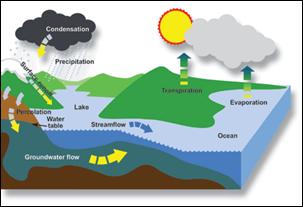
 .
. 

